Everyone is called to preach
In the preview for this column in the April print magazine, the question was posed: “What does it mean to testify?” But in light of the ongoing conversations, initiatives and movements to advance the roles of women in the church, the more pressing questions might be: “Who is called to testify? Who is called to preach?” Today’s Gospel gives us an answer that many church leaders are uncomfortable with acknowledging: Everyone is called, and it has nothing to do with gender.
On the first day of the week, Mary of Magdala came to the tomb early in the morning and saw the stone removed (Jn 20:1).
How can you inspire the faith of others through your words and actions?
What can you do to recognize and promote the gifts of all people?
How can Scripture inform the practices of the church today?
In the Gospel from John, we encounter the first person to preach and bear witness to the risen Christ: Mary Magdalene. Each of the Gospels record Mary discovering the empty tomb. In the Synoptic traditions, Mary is accompanied by a group of women who visit the tomb to anoint Jesus’ crucified body. In John, Mary uncovers the empty tomb alone, although her words suggest she may have been with others.
Mary’s actions reflect her awareness of the significance of the empty tomb, as she runs to inform others of what she has found. “They have taken the Lord from the tomb, and we don’t know where they put him.” The rest of today’s Gospel highlights Peter and the beloved disciple who race to see what Mary has proclaimed to them. They find the tomb empty, as she said. Peter sees the wrappings that covered Jesus’ body, and the beloved disciple sees the empty tomb and believes, the Gospel says, even though it does not fully explain what he believes. Instead, the Gospel reading today ends with those two disciples not fully understanding what has happened and then returning to their homes.
Though today’s reading ends there, the narrative does not, and it is unfortunate that the Lectionary abruptly cuts off, rather than continuing on to Jesus’ calling Mary to preach. If you attend mass on the Tuesday in the octave of Easter, you’ll hear the rest of the story. If not, you should read the text to capture the fullness of the tradition.
First, Mary remains at the tomb when the others leave. She weeps and is visited by two angels who question her action. Mary restates that she believes Jesus’ body had been removed from the tomb. Mary is then visited by the risen Christ, and she reiterates her concerns. Jesus calls her by name and sends her to proclaim his forthcoming ascension to the other disciples. “Mary…Go to my brothers and tell them, ‘I am going to my Father and your Father, to my God and your God.’” Mary follows her calling, announcing to the disciples, “I have seen the Lord,” and she tells them what Jesus told her.
Why does Jesus tell Mary to tell the disciples of his resurrection and ascension? What need is there for Mary to deliver this message if soon after Jesus would appear to the same disciples? Couldn’t Jesus just appear to them and relay the information? The traditions about what happens after the Resurrection reveal how a group of followers would develop into a church community that relies on all members to participate in its message and mission. Mary’s call to announce Jesus’ message to the other disciples is not just a matter of her having been the first on the scene. Rather, it reflects her openness to hearing and answering the call of God in her life as a follower of Jesus. Mary is not called because she is a woman just as the other disciples are not called because they are men. These early leaders, like the best leaders today, are open, devoted and effective at preaching the Gospel. They use their gifts and their faith to inspire others. This is what good preaching does, and it is not a gender-specific task.
Mary is a model for everyone on how to respond to the risen Christ: Proclaim the good news. Seek knowledge and clarity when you do not understand this mystery of faith, and inform and inspire the faith of others. On this Easter, as we celebrate Jesus’ triumphant resurrection, let Mary, the first person to witness and proclaim the resurrection, inspire all of us to do the same.








